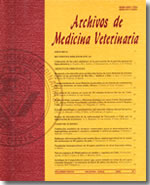Detection of lasalocid and monensin in raw milk samples from supplemented dairy cows
Main Article Content
Abstract
The ionophores lasalocid and monensin have been used as food additives to improve body weight gain in beef cattle and milk production in dairy cows. The aims of this work were to detect the presence of these compounds in raw milk samples and their ruminal disappearance rate in dairy cows using HPLC techniques. Two Friesian herds were used. Cows from one herd were supplemented with lasalocid and the other with monensin during 18 and 21 days respectively, and according to the recommended dose (300 mg/d). Daily raw milk samples were obtained during the supplementing period and the presence of lasalocid and monensin was analysed using HPLC techniques (LOD 30 and 5 ppb respectively). In a parallel trial fluid ruminal samples obtained from fistulised cows up to 24 hours after a single intra ruminal administration with the ionophores were analysed using the same HPLC techniques. Both ionophores were not detected in any of the milk samples during all the experimental period. The low transference of these ionophores to the milk could be related to their expected low absorption rate related to their physical-chemical proprieties. Lasalocid was detected in the ruminal fluid up to 6 hours after administration and monensin up to 4 hours of administration. According to the results, lasalocid and monensin are not detected in raw milk samples from supplemented cows using techniques with detection limits of 30 and 5 ppb, respectively.

